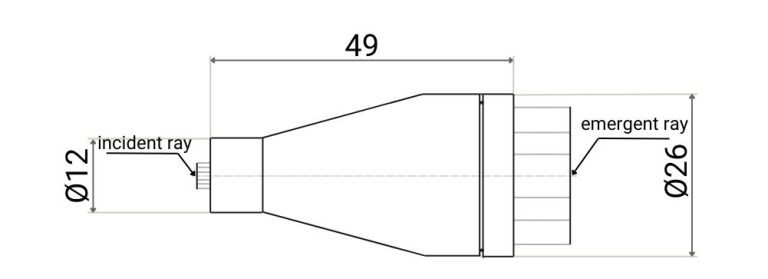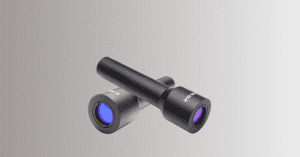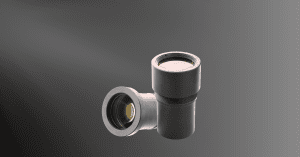Key Takeaways:
- The 50mm laser beam expander for 1064 nm wavelength provides precise 5X magnification, optimized for minimal losses and high transmission efficiency.
- It ensures superior optical quality with reduced aberrations, robust mechanical design for durability, and easy integration into various applications like laser scanning and material processing.
- Comprehensive testing and cost-effective design enhance reliability and performance, making it ideal for scientific, industrial, and medical uses.
Introduction
A beam expander is an optical device designed to increase the diameter of an incoming laser beam. It is commonly used in various scientific, industrial, and medical applications to enhance the performance and efficiency of laser systems. By expanding the beam, the device reduces the beam’s divergence, allowing it to travel longer distances with less spread. This is particularly useful in applications requiring high precision, such as laser cutting, welding, and surveying, as well as in optical communication systems and laboratory research.
Beam expanders are available in various designs, including Galilean and Keplerian configurations, each offering distinct advantages in terms of size, weight, and optical performance. They can be customized to accommodate different wavelengths and power levels of laser beams, making them versatile tools in optimizing laser applications.
Laser Beam Expander Lens specification
Wavelength | 1064 nm |
Magnifying power | 5X |
Entrance pupil diameter | 4mm |
Exit pupil diameter | 20mm |
Lens size | Φ26×50mm |

Design Overview of the Laser Beam Expander
The design of the optical system, particularly for a beam expander operating at a wavelength of 1064 nm, involves careful consideration of both optical and mechanical aspects to ensure performance and reliability. The beam expander in question features a magnifying power of 5X, converting a 4 mm entrance pupil diameter to a 20 mm exit pupil diameter. The overall lens size is specified to be Φ26×50 mm.
1. Optical Design
- Wavelength Specificity (1064 nm): The choice of materials and coatings for the lenses is crucial to ensure optimal transmission and minimal dispersion at the operating wavelength of 1064 nm. Typically, fused silica or other low-dispersion glasses are selected for such applications due to their excellent performance in the near-infrared region.
- Magnifying Power (5X): The optical design must ensure a precise magnification factor of 5X. This involves the selection and arrangement of lens elements to achieve the desired beam expansion without introducing significant aberrations. Typically, a Keplerian or Galilean design is utilized for beam expanders.
- Entrance and Exit Pupil Diameters: With an entrance pupil diameter of 4 mm and an exit pupil diameter of 20 mm, the lens system is designed to expand the beam uniformly while maintaining beam quality. The optical path must be carefully optimized to ensure minimal wavefront distortion and maintain a collimated output.
2. Opto-Mechanical Design
- Lens Size (Φ26×50 mm): The physical dimensions of the lens assembly (Φ26×50 mm) dictate the housing and mounting requirements. The mechanical design ensures robust alignment and stability of the optical elements within these constraints.
- Mechanical Tolerances and Alignment: Precise mechanical tolerances are necessary to ensure proper alignment and centration of the optical components. This minimizes alignment errors and ensures consistent performance.
- Material Selection: The housing material must provide structural stability and thermal compatibility with the optical elements. Typically, anodized aluminum or stainless steel is used for its durability and ease of machining.
3. Simulation Results
- Ray Tracing: To ensure that the beam path is correctly aligned and that the magnification and beam quality are as intended.
- Wavefront Analysis: To check for aberrations and ensure that the wavefront distortion remains within acceptable limits.
- Thermal Analysis: To ensure that the system can withstand operational temperature ranges without significant misalignment.
4. Test Results
Upon fabrication, the system undergoes rigorous testing to ensure that it meets the specified criteria. The test results include:
- Alignment and Centration Errors: detailed measurements to ensure that any misalignment or decentration is within acceptable tolerances. This ensures that the optical performance is not degraded.
- Physical Dimensions: Verification of the physical dimensions of the beam expander, ensuring compliance with the specified Φ26×50 mm size.
- Divergence Angle Values: Measurement of the output beam divergence to confirm that the expanded beam remains collimated as per design specifications.
Advantages of Laser Beam Expander
- High-Quality Beam Expansion:
-
-
- Accurate Magnification (5X): The beam expander magnifies the input beam from 4 mm to 20 mm, crucial for applications requiring a larger beam for better resolution or reduced divergence.
-
- Wavelength Optimization:
-
-
- Efficiency: Optical elements and coatings are optimized for 1064 nm, ensuring maximum transmission efficiency and minimal losses. This design reduces chromatic aberrations and enhances performance.
-
- Superior Optical Quality:
-
-
- Minimized Aberrations: The design maintains high wavefront quality, essential for precise beam shaping and focusing. The output beam remains collimated, reducing divergence over longer distances.
-
- Robust Mechanical Design:
-
-
- Stability: Precise alignment and robust materials ensure long-term durability and reliability in demanding environments.
-
- Versatile Applications:
-
-
- Compatibility: Suitable for laser scanning, material processing, medical devices, and scientific research. The design allows easy integration with existing optical setups.
-
- Ease of Testing and Validation:
-
-
- Verification: Detailed test results, including alignment and divergence angles, allow users to verify performance quickly. Pre-fabrication simulations predict system performance, reducing errors and enhancing confidence.
-
- Cost-Effective Solution:
-
- Efficiency: Careful material selection and efficient design lower manufacturing costs while maintaining high performance. The robust design reduces maintenance needs, providing a cost-effective solution over the system’s lifetime.
Conclusion
This 50mm beam expander stands out as a highly reliable and versatile optical component. Its precise magnification, wavelength optimization, high optical quality, robust mechanical design, versatility, ease of testing, cost-effectiveness, and advanced capabilities make it an ideal choice for various applications requiring dependable and high-quality beam expansion. The advanced features ensure superior performance and cutting-edge technology integration, allowing for exceptional adaptability and efficiency in both standard and demanding environments. This makes the beam expander not only a robust and reliable tool but also a forward-looking solution capable of meeting future technological advancements and application needs.
Related Content:
GREAT ARTICLE!
Share this article to gain insights from your connections!





